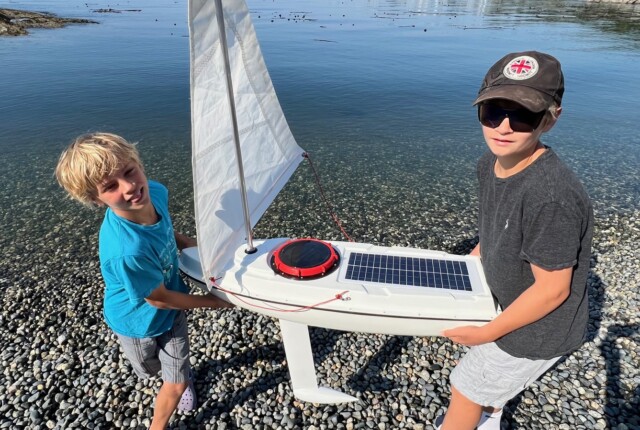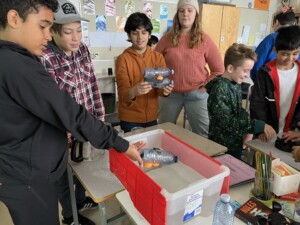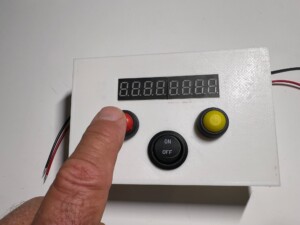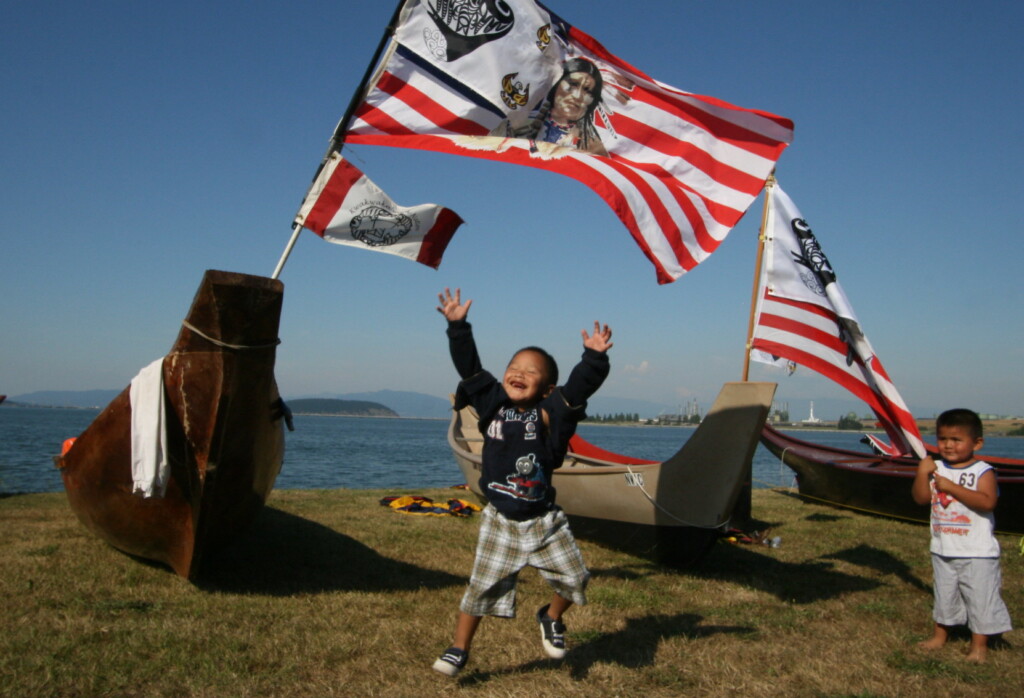The Ultimate Learning Adventure
 Wind Wanderer is created as the core component for a unique educational platform, transforming the age-old romance of a message in a bottle into a sophisticated tool for modern learning. This ocean-crossing vessel serves as a conduit from classroom to the deep sea, a realm that remains largely uncharted and lightly touched by human presence. It is an opportunity for students to be immersed in a world they would not otherwise have the means to explore.
Wind Wanderer is created as the core component for a unique educational platform, transforming the age-old romance of a message in a bottle into a sophisticated tool for modern learning. This ocean-crossing vessel serves as a conduit from classroom to the deep sea, a realm that remains largely uncharted and lightly touched by human presence. It is an opportunity for students to be immersed in a world they would not otherwise have the means to explore.
Measuring just under 4 feet (105 cm) in length, Wind Wanderer is designed to embark on journeys across the ocean, guided solely by the prevailing winds and currents. Its progress can be followed in real-time via a satellite tracking, accessible through our online dashboard. Wind Wanderer is distinct from our other models in the fact it is not remotely controlled. Instead, using a cloth sail, it passively follows a downwind course, guided by the prevailing winds.
We have curated accompanying curriculum that encapsulates principles of geography, oceanography, robotics, and physics, providing students with tangible context for their studies. The process of preparing for the vessel’s launch, coupled with the anticipation of its journey and ultimate discovery, transforms abstract concepts into a captivating adventure. A small cargo bay can be filled with gifts and keepsakes. When the boat is close to reaching its destination, local schools can be contacted to retrieve the boat from the water providing a cultural connection with students a world away.
To enhance its role as a floating classroom, the Wind Wanderer can be equipped with additional sensors to collect environmental data, such as water and air temperatures, barometric pressure, wind speed and direction, and wave height. Data collected by this boat is logged onboard, and can only be obtained when the boat is retrieved. For those that wish to utilize/visualize data in real time or to be able to control the boat’s course, we recommend Silicon Sailor or Hybrid Voyager. Two data logging sensor packages are available for Wind Wanderer.
While the boat was primarily designed as a classroom educational tool, it can also be used as a research data buoy with the sail serving as an effective means of propelling the boat away from shore, negating the need to launch from a ship.
 Normally, the boat sails passively straight downwind, and is balanced so as not to require a rudder. A unique and proprietary feature (optional) of this vessel, however, is the ability to configure the sail to propel the vessel sideways to the wind for a pre-determined length of time. This is useful for launching the vessel from areas where the wind blows parallel or towards shore. Once the boat is safely offshore an electronic controller changes sail position, and it will start steering straight downwind. An alternative option, suitable for research purposes, is having the sail drop into the water, turning into a drogue. This slows the boat down, making it an ideal platform for gathering metocean data. This option is called Sail Clock and is available in our store as an option.
Normally, the boat sails passively straight downwind, and is balanced so as not to require a rudder. A unique and proprietary feature (optional) of this vessel, however, is the ability to configure the sail to propel the vessel sideways to the wind for a pre-determined length of time. This is useful for launching the vessel from areas where the wind blows parallel or towards shore. Once the boat is safely offshore an electronic controller changes sail position, and it will start steering straight downwind. An alternative option, suitable for research purposes, is having the sail drop into the water, turning into a drogue. This slows the boat down, making it an ideal platform for gathering metocean data. This option is called Sail Clock and is available in our store as an option.
A subscription for the satellite tracker and online viewing dashboard is also required for this boat.
Please Note: our company is brand spanking new products will not be available for purchase until August 2025. Preorders can be made by contacting us directly. Purchasing options will include buying directly through our online store, or we can provide a commercial invoice with standard industry payment options.
Your Questions Answered
A cloth sail was chosen for Wind Wanderer for versatility, economy and simplicity. It propels the boat just as well as the rigid wing sails of our more expensive models, and will last more than eight months on the ocean. For multiple ocean voyages, new sails can be purchased.
Absolutely! It’s pretty complex creating a dashboard, tracker, etc. but if your class is really ambitious and guided by someone knowledgeable, you can simply purchase the boat and install your own system.
The software/tracker subscription includes tracking, a dedicated online dashboard just for your boat (not shared) and met ocean data sourced from third-party sources and displayed on your dashboard. The tracker page can be viewed by unlimited people. Widgets display information such as wave height, temperature, wind speed and direction, etc. Note this data is not sourced from the boat, but from third party weather/ocean models for the location. Location updates are provided hourly through the Global star satellite network.
 Yeah, it’s a little confusing, but here goes: Unlike our other models, the boat’s course can’t be controlled remotely. Instead, in its default configuration it sails passively downwind. When we say “passively” this means no controls (such as a rudder and servo) are required to sail this way. With zero external input, the boat will remain on a balanced downwind course for eternity. Sailing at this angle is optimal for simple ocean crossings, where the boat merely follows the prevailing winds. The challenge, however, is getting offshore. Let’s say, for example, you’re a school from Wilmington, North Carolina and you want to launch your Wind Wanderer from the beach and have it hopefully make it to somewhere on the other side of the Atlantic. The problem, however, is often, in Wilmington, the winds blow parallel to the shore or into shore. The more consistent SW winds are further offshore. So, to get away from the coast, going straight downwind may not be the best course of sail. That’s where our unique sail control system comes in. The sail can be adjusted to an angle that allows it to hold a balanced point of travel at a ninety degree angle to the wind on a specific port or starboard tack. This allows the boat to make progress away from shore when the winds aren’t blowing offshore. After a set number of days, a small solenoid releases the sail and it shifts into position that allows straight downwind sailing. The operator of the boat can input, in advance of launching the vessel, the number of hours/days they want to hold the original sail configuration for. It is a very user-friendly unit with three buttons and a countdown display. This sail control mechanism is an optional item and can be found in our store labeled Sail Clock
Yeah, it’s a little confusing, but here goes: Unlike our other models, the boat’s course can’t be controlled remotely. Instead, in its default configuration it sails passively downwind. When we say “passively” this means no controls (such as a rudder and servo) are required to sail this way. With zero external input, the boat will remain on a balanced downwind course for eternity. Sailing at this angle is optimal for simple ocean crossings, where the boat merely follows the prevailing winds. The challenge, however, is getting offshore. Let’s say, for example, you’re a school from Wilmington, North Carolina and you want to launch your Wind Wanderer from the beach and have it hopefully make it to somewhere on the other side of the Atlantic. The problem, however, is often, in Wilmington, the winds blow parallel to the shore or into shore. The more consistent SW winds are further offshore. So, to get away from the coast, going straight downwind may not be the best course of sail. That’s where our unique sail control system comes in. The sail can be adjusted to an angle that allows it to hold a balanced point of travel at a ninety degree angle to the wind on a specific port or starboard tack. This allows the boat to make progress away from shore when the winds aren’t blowing offshore. After a set number of days, a small solenoid releases the sail and it shifts into position that allows straight downwind sailing. The operator of the boat can input, in advance of launching the vessel, the number of hours/days they want to hold the original sail configuration for. It is a very user-friendly unit with three buttons and a countdown display. This sail control mechanism is an optional item and can be found in our store labeled Sail Clock
The boat needs to be launched from a location where it will be able to voyage across an ocean with prevailing winds and currents, away from the micro systems near shore. In the northern hemisphere, prevailing winds and currents go in a large clockwise circuit. For the Atlantic, the winds and currents in the south flow east into the Gulf of Mexico, veer up the coast towards Nova Scotia, and then start curving back towards Europe again. This means that once the boat gets far enough from shore it will be caught in the Gulf Stream and ultimately make its way east towards Europe. For boats launched off the west coast of America, they will be swept south and then west, following a curving route towards Hawaii or French Polynesia before heading more directly west. It is important to launch in a non-congested area where the vessel can make its way offshore without getting washed up on shoals, islets or other obstacles. They can also be launched further out from a mother ship.
A small bit of assembly and preparation is required when you receive the boat. There is just enough to give students a feeling of ownership over the project, without it being too complex. We provide concise instructions for assembly, so you don’t need to be mechanically inclined to lead the project. Assembly and preparations include installing the mast and sail, plugging together electrical connectors, and other small jobs. Additionally, antifouling paint needs to be applied to the bottom of the boat. The rest of the vessel can also be painted in a manner to reflect the spirit and creativity of your school.
The satellite tracker is powered by a solar panel and reservoir battery, so can feasibly last indefinitely. As long as the boat isn’t heavily damaged, it can be tracked for years. The tracker/dashboard subscription needs to be renewed after a year.
No, the boats will almost always be retrieved from its location of landfall. One of the highlights of these crossings is the cultural connection creatd when the vessel gets to the other side. In this process, a school or organization in the region of landfall is contacted and asked to retrieve the boat from the water. Even in areas that there are no schools, there is usually some sort of administrative body that can be contacted. In the rare occasions where the boat loses satellite connection and washes up at an unknown location, it will likely still be retrieved. Unlike a laundry bottle, or chunk of Styrofoam, something as unusual as a robotic boat will provide enough intrigue for a passerby to bring it home.
At this time, we offer two sensor packages for wind wanderer. One includes air temperature, water temperature and barometric pressure. The second (deluxe) includes these same sensors plus wave sensor (height and period), wind speed and direction. Data from the sensors is logged onboard, and is retrieved after the mission is over. For those interested in having greater sensor options, and the ability to transmit in real time, we recommend upgrading to one of our more advanced boats.
We are continuing to expand our corresponding curriculum. It includes various STEM activities that relate to different elements of the project including principles such as buoyancy, self righting, magnetic couplings, geography, oceanography, and cultural research. An example of one of our projects involves breaking the class into several groups. Each team is provided with a bottle, coins, ping pong ball and duct tape and is challenged to make a self-righting boat. The boats are then tested in a tub of water at the end of the class. Other projects relate directly to the boat such as brainstorming the gifts/mementos that will go in the cargo hold to the recipient school or assembling the vessel.
Packages

Basic
Wind Wanderer - Composite Boat Only
Our basic package includes the boat only. This includes solar panel, charge controller, battery, mast, sail, and hull and decks made from exotic composition construction techniques. It does not include the software and tracker package. The basic package is only recommended for advanced groups capable of developing their own tracking systems.
standard
Boat and One Year Software/Tracking
- USV Sailing Vessel
- Satellite Tracking Hardware configured to run off solar.
- Global Star Satellite Tracking Subscription
- Tracker Page with unlimited viewing
- Third party met-ocean data displayed on tracker page
- Tech support
silver
Boat, Software, and Basic Sensor Pack
- USV Sailing Vessel
- Satellite Tracking Hardware configured to run on solar
- Globalstar Tracking Subscription for a year
- Tracker Page with unlimited viewing
- Third Party met-ocean data displayed on tracker page
- Basic Sensor logging package
- Tech support
